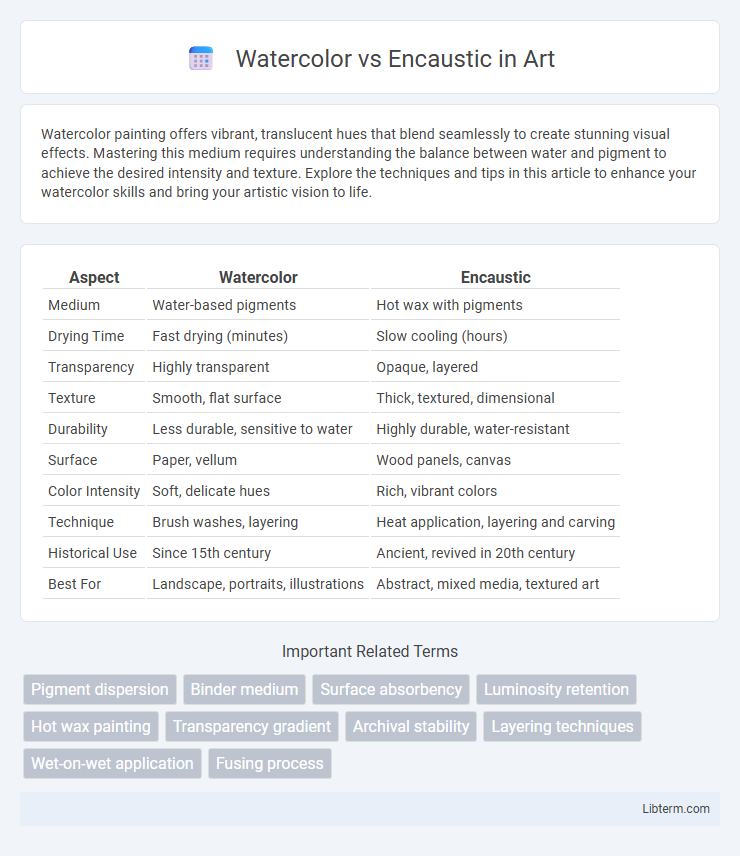Watercolor painting offers vibrant, translucent hues that blend seamlessly to create stunning visual effects. Mastering this medium requires understanding the balance between water and pigment to achieve the desired intensity and texture. Explore the techniques and tips in this article to enhance your watercolor skills and bring your artistic vision to life.
Table of Comparison
| Aspect | Watercolor | Encaustic |
|---|---|---|
| Medium | Water-based pigments | Hot wax with pigments |
| Drying Time | Fast drying (minutes) | Slow cooling (hours) |
| Transparency | Highly transparent | Opaque, layered |
| Texture | Smooth, flat surface | Thick, textured, dimensional |
| Durability | Less durable, sensitive to water | Highly durable, water-resistant |
| Surface | Paper, vellum | Wood panels, canvas |
| Color Intensity | Soft, delicate hues | Rich, vibrant colors |
| Technique | Brush washes, layering | Heat application, layering and carving |
| Historical Use | Since 15th century | Ancient, revived in 20th century |
| Best For | Landscape, portraits, illustrations | Abstract, mixed media, textured art |
Introduction to Watercolor and Encaustic Art
Watercolor art utilizes pigments suspended in a water-based solution, allowing artists to achieve translucent washes and subtle color gradients on paper. Encaustic art, also known as hot wax painting, involves mixing colored pigments with heated beeswax, which is then applied to a surface, typically wood or canvas, creating textured, layered effects. Both mediums require distinct techniques and tools, with watercolor emphasizing fluidity and spontaneity, while encaustic focuses on layering and durability.
Historical Background of Watercolor and Encaustic
Watercolor painting traces its roots back to ancient Egypt, where early artists used mineral pigments mixed with water to create vibrant images on papyrus. Encaustic art, originating in ancient Greece around the 5th century BCE, involved the use of heated beeswax mixed with colored pigments, allowing for durable and richly textured artworks. Both techniques have evolved through centuries but maintain distinct cultural and historical significance, with watercolor flourishing in manuscript illumination and encaustic prominent in Fayum mummy portraits.
Materials and Tools: Watercolor vs Encaustic
Watercolor painting utilizes transparent pigments suspended in water applied with brushes on paper, emphasizing the fluidity and layering of washes. Encaustic painting requires heated beeswax mixed with colored pigments, applied with metal tools and brushes on rigid surfaces like wood panels for textured, dimensional effects. The distinct materials--water-based paints versus wax-based medium--and specialized tools define the unique techniques and resulting aesthetics of each art form.
Techniques and Application Methods
Watercolor techniques involve transparent washes and layering with water-soluble pigments applied on paper, allowing for fluid blending and soft gradients. Encaustic methods use heated beeswax mixed with colored pigments applied with brushes or heated tools onto rigid surfaces, enabling textural effects and dimensional layering. Watercolor emphasizes delicate translucency and spontaneous flow, while encaustic provides a durable, sculptural quality with rich surface texture.
Color Vibrancy and Texture Comparison
Watercolor produces translucent, luminous color layers that create soft gradients and subtle texture variations, ideal for delicate, ethereal effects. Encaustic uses heated beeswax mixed with pigments, resulting in rich, vibrant colors with a luminous, tactile surface and pronounced texture from brushstrokes or tools. The dense layering potential of encaustic leads to a three-dimensional quality, whereas watercolor's fluidity emphasizes light transparency over surface texture.
Drying Time and Layering Capabilities
Watercolor dries quickly, often within minutes, allowing for rapid layering but with limited control over blending due to its transparency and fluidity. Encaustic paint, composed of heated beeswax and pigment, cools and hardens more slowly, providing extended working time for blending and manipulating texture across multiple thick layers. This slower drying process enables encaustic artists to build rich, three-dimensional surfaces with intricate layering techniques unattainable in traditional watercolor.
Durability and Preservation
Encaustic painting, using heated beeswax mixed with pigments, offers superior durability and preservation compared to watercolor, as wax resists moisture, UV light, and environmental pollutants, ensuring longevity of colors and texture. Watercolor, composed of pigment suspended in a water-soluble binder, is prone to fading and damage from humidity and direct sunlight, requiring protective framing and controlled environments for preservation. Museums and collectors favor encaustic works for archival quality, as they maintain vibrancy and structural integrity over centuries under proper conditions.
Artistic Styles and Versatility
Watercolor painting offers translucency and fluidity, allowing artists to create delicate washes and subtle gradients that emphasize light and spontaneity, ideal for landscapes and portraits. Encaustic, using heated beeswax mixed with pigments, provides a textured, layered effect with vibrant colors and durability, enabling sculptural techniques and mixed-media applications. While watercolor excels in quick, expressive works, encaustic's versatility supports both detailed realism and abstract compositions through its dimensionality and archival quality.
Cost and Accessibility
Watercolor painting typically requires minimal investment in basic supplies like paints, brushes, and paper, making it cost-effective and accessible for beginners. Encaustic art involves higher costs due to specialized materials such as heated wax, pigments, and tools like hot plates or heat guns, which can limit accessibility. Watercolor's portability and ease of setup also contribute to its widespread availability compared to the more equipment-intensive encaustic process.
Choosing the Right Medium for Your Art
Watercolor offers translucency and fluidity, perfect for artists seeking soft gradients and spontaneous effects, while encaustic provides rich texture and durability with its layered wax technique. Consider your desired visual impact and working style; watercolor suits quick, portable projects, whereas encaustic demands specialized tools and longer drying times for multidimensional pieces. Selecting between these mediums hinges on balancing ease of use, texture preferences, and the longevity of your artwork.
Watercolor Infographic

 libterm.com
libterm.com